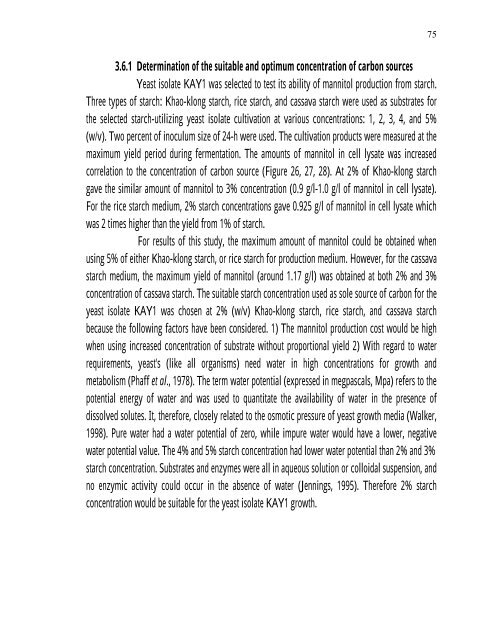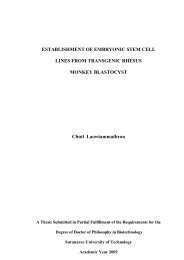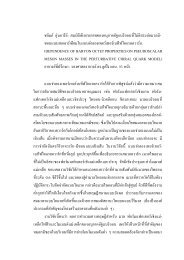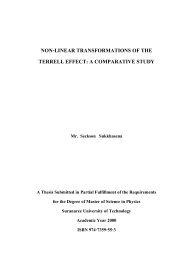PRODUCTION Of NUTRIENT SOURCES FOR RHIZOBIUM
PRODUCTION Of NUTRIENT SOURCES FOR RHIZOBIUM
PRODUCTION Of NUTRIENT SOURCES FOR RHIZOBIUM
You also want an ePaper? Increase the reach of your titles
YUMPU automatically turns print PDFs into web optimized ePapers that Google loves.
3.6.1 Determination of the suitable and optimum concentration of carbon sources<br />
Yeast isolate KAY1 was selected to test its ability of mannitol production from starch.<br />
Three types of starch: Khao-klong starch, rice starch, and cassava starch were used as substrates for<br />
the selected starch-utilizing yeast isolate cultivation at various concentrations: 1, 2, 3, 4, and 5%<br />
(w/v). Two percent of inoculum size of 24-h were used. The cultivation products were measured at the<br />
maximum yield period during fermentation. The amounts of mannitol in cell lysate was increased<br />
correlation to the concentration of carbon source (Figure 26, 27, 28). At 2% of Khao-klong starch<br />
gave the similar amount of mannitol to 3% concentration (0.9 g/l-1.0 g/l of mannitol in cell lysate).<br />
For the rice starch medium, 2% starch concentrations gave 0.925 g/l of mannitol in cell lysate which<br />
was 2 times higher than the yield from 1% of starch.<br />
For results of this study, the maximum amount of mannitol could be obtained when<br />
using 5% of either Khao-klong starch, or rice starch for production medium. However, for the cassava<br />
starch medium, the maximum yield of mannitol (around 1.17 g/l) was obtained at both 2% and 3%<br />
concentration of cassava starch. The suitable starch concentration used as sole source of carbon for the<br />
yeast isolate KAY1 was chosen at 2% (w/v) Khao-klong starch, rice starch, and cassava starch<br />
because the following factors have been considered. 1) The mannitol production cost would be high<br />
when using increased concentration of substrate without proportional yield 2) With regard to water<br />
requirements, yeast's (like all organisms) need water in high concentrations for growth and<br />
metabolism (Phaff et al., 1978). The term water potential (expressed in megpascals, Mpa) refers to the<br />
potential energy of water and was used to quantitate the availability of water in the presence of<br />
dissolved solutes. It, therefore, closely related to the osmotic pressure of yeast growth media (Walker,<br />
1998). Pure water had a water potential of zero, while impure water would have a lower, negative<br />
water potential value. The 4% and 5% starch concentration had lower water potential than 2% and 3%<br />
starch concentration. Substrates and enzymes were all in aqueous solution or colloidal suspension, and<br />
no enzymic activity could occur in the absence of water (Jennings, 1995). Therefore 2% starch<br />
concentration would be suitable for the yeast isolate KAY1 growth.<br />
��






